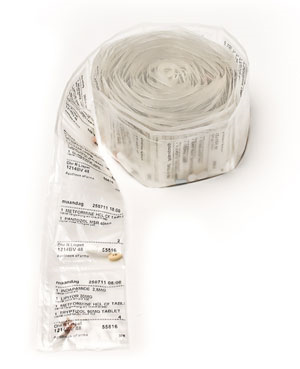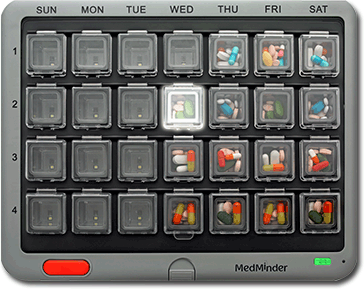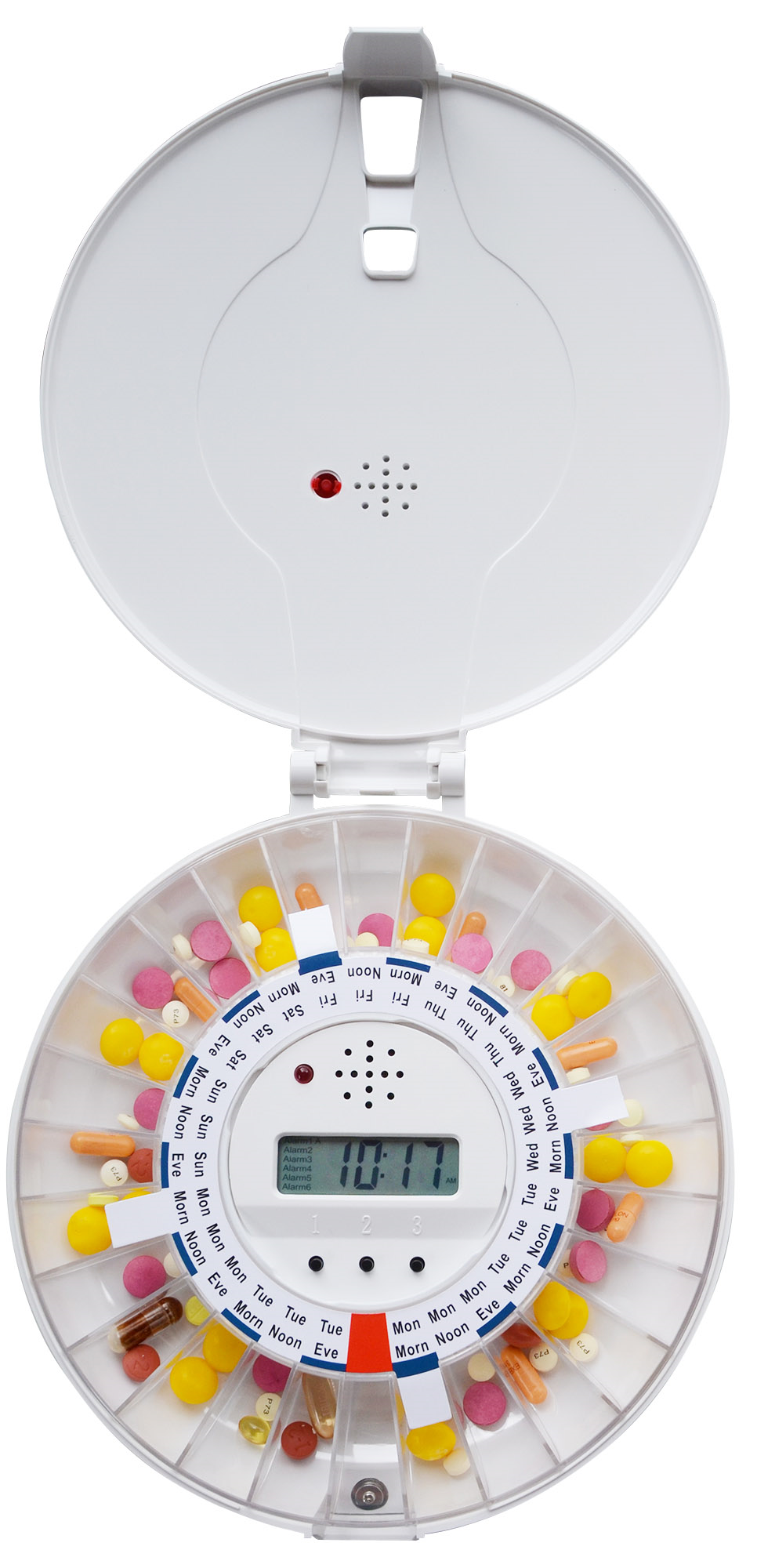PRE2016 3 Groep9: Difference between revisions
| Line 130: | Line 130: | ||
---- | ---- | ||
== The design process/progress == | |||
== References == | == References == | ||
Revision as of 20:49, 3 March 2017
Medicine/pill dispenser system
- Group 9
- Chiel Düthmann
- Dirk van Wijk
- Jasper Hoek
- Mark van der Pas
- Yoshi de Laat
- Maija Rintala
Introduction
More and more people, especially elderly, have complex medication disciplines, with a whole range of different medicines. It is important to take the right medicines, in the right dose, at the right time. Missing a dose or taking more medicines than necessary could lead to dangerous situations, but also taking medicines that don’t go together at the same time, may have negative consequences. In 2013 almost 49,000 people older than 65 were admitted to the hospital because of wrong medication use, of which 48% could have been prevented (‘Vervolgonderzoek Medicatieveiligheid’). A system that would remind the user to take his medicines and dispenses the right medicines at the moment they have to be taken, would prevent a big part of these situations. The electronic devices and internet connection in your house provides extra possibilities for such a system. Therefore we want to design a smart system that dispenses medicines. This system will have the basic function of a medicine dispenser: dispense the right medicines and notify the user if he/she has to take his medicines by an alarm. However, because it will be connected to the internet, there are extra possibilities for notifications on smartphone and an automatic update of the medication discipline if the doctor’s prescription changes. This wiki page will describe our project, including state-of-the-art, literature research, and the design process.
- Goals
- Design a simple and safe medicine dispenser
- Easy to use, especially for elderly and disabled
- Smart; uses internet of things
- Secure
- Easy to refill
- Challenges
- What are critical parts of the system?
- What functions should the design include?
- What will the interface look like?
- Who is responsible if something goes wrong?
- How to design a dispenser that doesn't jam?
- How will the device function without an internet connection?
- How is it refilled?
- Will this increase the workload of doctors?
- Approach
- Conduct a literary study of existing technology to achieve our goals and solve our challenges
- Design the prototype
- Build the prototype
- Program the prototype
USE Aspects
We've regocnized these USE groups relevant to our design:
User: Doctors, Pharmacists, Patients
Society: Elderly, Disabled people, Elderly care workers, Medical Institutions, Family of users
Enterprise: Pharmaceuticals
State of The Art
There are various non electronic ways to assist people in taking the right medicines at the right moment. For instance the box system like in figure 1
, it consist of seven boxes, one for each day of the week, and every box has four compartments corresponding to four times of the day (morning, noon, afternoon and evening). The user can simply take out the box in front and take the medicines out every time this is needed. Another existing system is the medication roll (figure 2)
. This roll consists of plastic pouches filled with the medicines for a moment on the day (which moment is indicated on the pouches). The pharmacy can provide these rolls filled with all medicines.
A major disadvantage of both systems is that the user still can forget to take his medicines, since there is no alarm, it also has no warning system if a dosage is missed, and the user can accidently take the medicines from the wrong box or pouch. Another disadvantages of the medication roll is that if there is a change in the medication discipline this cannot be changed immediately, since the medicines for the coming week(s) are already packed in plastic. Next to these systems there are also various electronic medicine dispenser systems on the market, most of them are quite basic, however there are also some more advanced ones.
Electronic medicine boxes
One of the more basic systems is the electronic medicine box, like the MedMinder (figure 3)
. . The system has 28 trays each can be loaded with one dosage. For how many weeks/days the dispenser can be filled depends on the number of dosages per day, for instance with two dosages per day the dispenser can hold two weeks of medication. If a dosage has to be taken, the right compartment will unlock and a led will blink. The system can be extended with different types of reminders (like a bracelet), a telephone connection and a medical alert function.
E-pill
E-pill (figure 4) is a round device where you load in the medication discipline for the coming days, like in the medicine box so each box contains the medicines for one moment in time. The date and time of the alarm can be set. If the user has to take the medicines, the disk will rotate to the right box, an alarm will sound and the medicines can be taken out. E-pill has some variants, but they all work basically the same.
Philips Lifeline
The device of Philips works somewhat the same as the e-pill device. The medicines are loaded into cups and placed into the dispenser. An extra advantage of the system of Philips is that it can connect to the telephone line, so someone can be notified if a dose is missed. (Philips Lifeline)
Evondos E300
The Evondos E300 is a compact system where you load in a medication roll with the right doses of the medicines, delivered by your pharmacy. It gives an alarm if the user has to take his or her medicines and by a push on the button the right medicine dose comes out. This system has a display where instructions on how to take the medicines can be shown and it is connected to the caregiver’s Telecare system by the internet. So when medicines are not taken this can be notified. (Evondos)
Last few years there are more projects and product developments ongoing that work on smart medicine dispenser systems, like the one we want to create. For instance we encountered a product/project on Kickstarter, Lumma automated medication sorter and dispenser (Kickstarter, Lumma).
Planning
This part describes a general planning of our project, including important milestones.
Week 2
- Literature study (state-of-the-art)
- Define objectives + deliverables
Week 3 + Carnaval holiday
- Determination of all functions of the robot (pill dispenser)
- Designing the pill dispenser paper so we know what to order
- Determine what functions the prototype will have and how we will build it (materials, electronics, etc.)
- Literature study (continued)
- Start on software design
Week 4
- CAD sketch (based on sketch on paper)
- Gathering + ordering parts needed for the dispenser prototype
Week 5
- Finish software, build prototype
Week 6
- Finish prototype
Week 7
- Test prototype
Week 8
- Final presentation
- Finish wiki
Every week
- Update wiki with project and design progress, including description of the state-of-the-art and USE aspects.
The design process/progress
References
- Vervolgonderzoek Medicatieveiligheid, opgesteld voor het Ministerie van VWS. January 2017
- Philips Lifeline. Lifeline Philips. Retrieved from https://www.lifeline.philips.com/health-solutions/health-mdp.html, 22 February 2017
- Evondos. Evondos e300 automatic medicine dispenser. Retrieved from http://evondos.com/service/evondos-e300-automatic-medicine-dispenser/, 22 February 2017
- Kickstarter. Lumma, automated medication sorter and dispenser. Retrieved from https://www.kickstarter.com/projects/402921688/lumma-automated-medication-sorter-and-dispenser, 23 February 2017
Sources
- Figure 1: http://www.winkelmetzorg.nl/a-15208551/medicijnendoos-of-pillendoos-met-alarm-hulpmiddelen-met-alarm/pillendoos-met-braille-medicijnendoos-met-braille-medidaily-pillen-bewaar-opbergdoos/
- Figure 2: https://www.efarma.nl/pages/sectieinfo.asp?SUBSC=16010
- Figure 3: https://www.medminder.com/
- Figure 4: http://www.epill.com/dispenser.html



